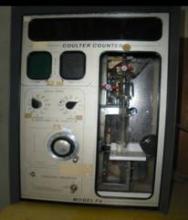THE ELECTRONIC particle counter developed by Coulter (1956), immediately provided a new dimension to blood cell counting and sizing The first person to show that the instrument was sensitive enough to monitor bacteria was Kubitschek (1958, 1960), who produced volume profiles of growing Escherichia coli B. and germinating Bacillus megaterium spores, after modifying the existing apparatus to increase sensitivity. Most of the earlier work with Coulter Counters was performed with pure cultures where experimental conditions were controlled to provide optimum working conditions. In these circumstances the instrument generally provided total counts and/or size distribution curves of cells in various microbiological systems ; sometimes purely as an alternative to established methods of performing these functions but mainly in an analytical capacity for studying aspects of cell and spore physiology to indicate specific metabolic activities.
Spore volume and shape of volume distribution curves have also been assessed for possible use in fungal taxonomy
The instrument
The instrument (model Fn Coulter Counter), designed specifically for haematology, but sensitive enough to detect and count bacterial cells. Although the Coulter principle and methodology are well documented, a short recapitulation is included to acquaint workers who may be unfamiliar with the instrument.
Coulter principle. An electric current is passed through an electrolyte and between two platinum electrodes positioned one each side of an orifice, which for bacteria is usually 30 pm in diameter. A suspension of particles (0-05 ml) in the same electrolyte as above, is drawn through the orifice by unbalancing a mercury manometer system, a typical count cycle taking 13 s. Each non-conducting particle produces a change in the electrical conductivity of the electrolyte within the orifice, by displacing its own volume of electrolyte. This change produces a voltage pulse which is amplified and displayed on an oscilliscope screen, where pulse amplitude is proportional to the volume of the particle producing it.

